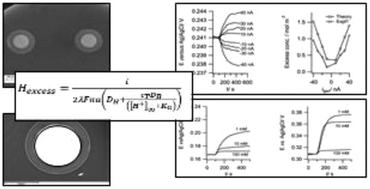Microelectrode generator–collector systems for electrolytic titration: theoretical and practical considerations†
Abstract
Electochemical generator–collector systems, where one electrode is used to generate a reagent, have a potentially large field of application in sensing and measurement. We present a new theoretical description for coplanar microelectrode disc–disc systems where the collector is passive (such as a potentiometric sensor) and the generator is operating at constant flux. This solution is then used to develop a leading order solution for such a system where the reagent reacts reversibly in solution, such as in acid–base titration, where a hydrogen ion flux is generated by electrolysis of water. The principal novel result of the theory is that such devices are constrained by a maximum reagent flux. The hydrogen ion concentration at the collector will only reflect the buffer capacity of the bulk solution if this constraint is met. Both mathematical solutions are evaluated with several microfabricated devices and reasonable agreement with theory is demonstrated.



 Please wait while we load your content...
Please wait while we load your content...